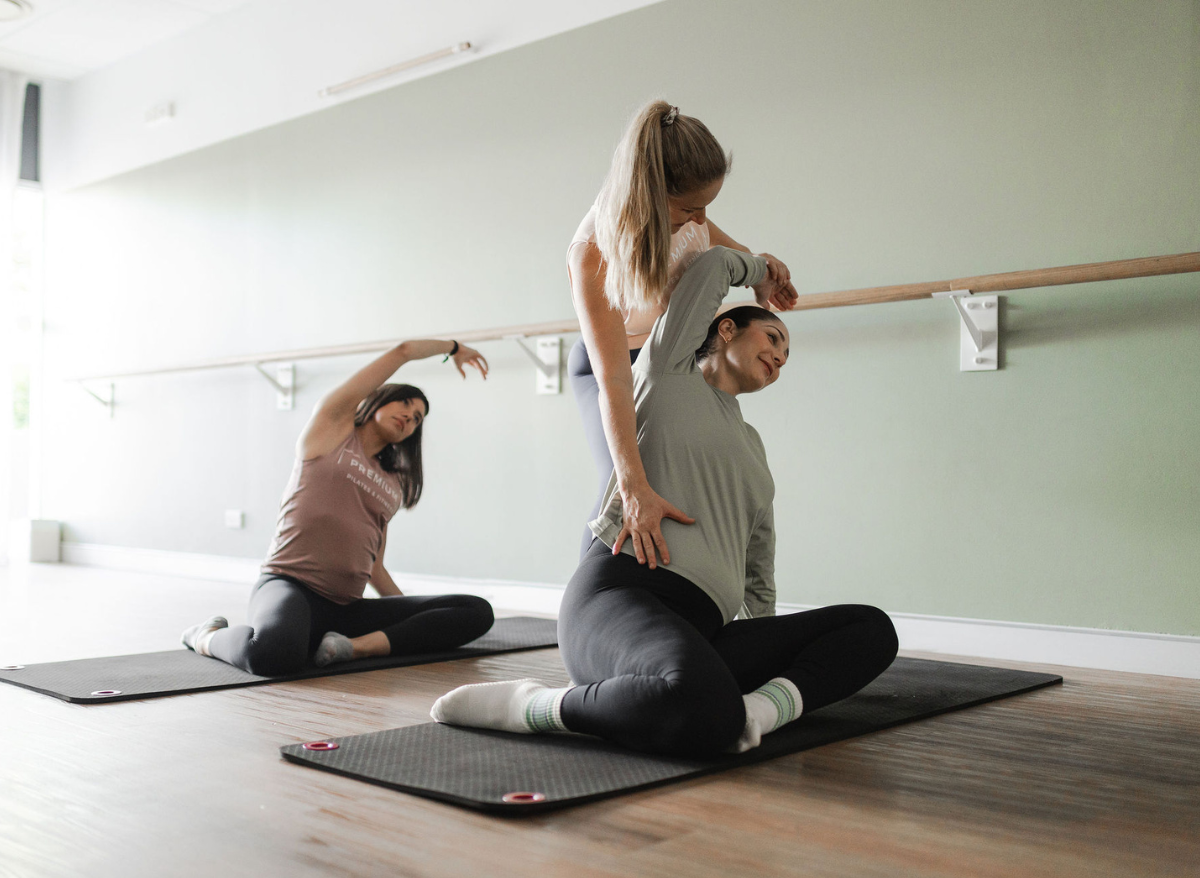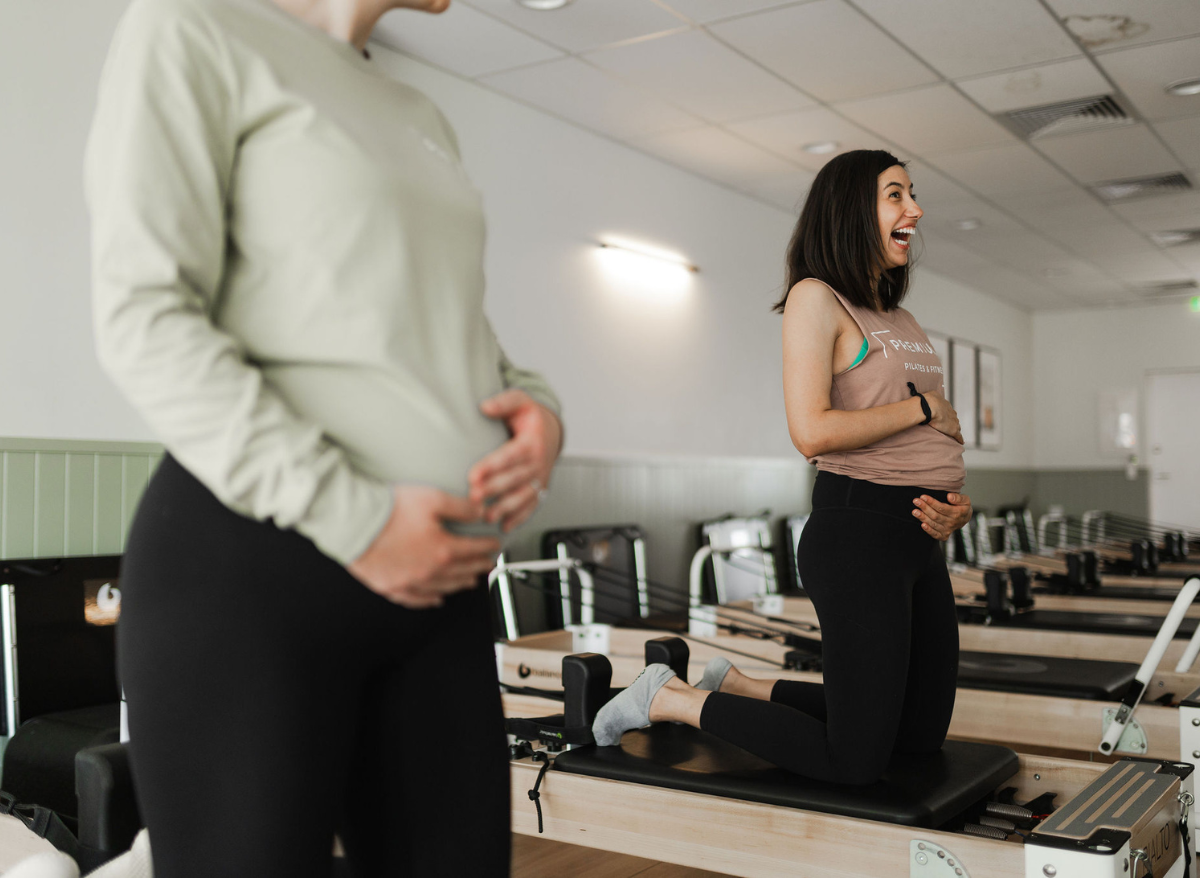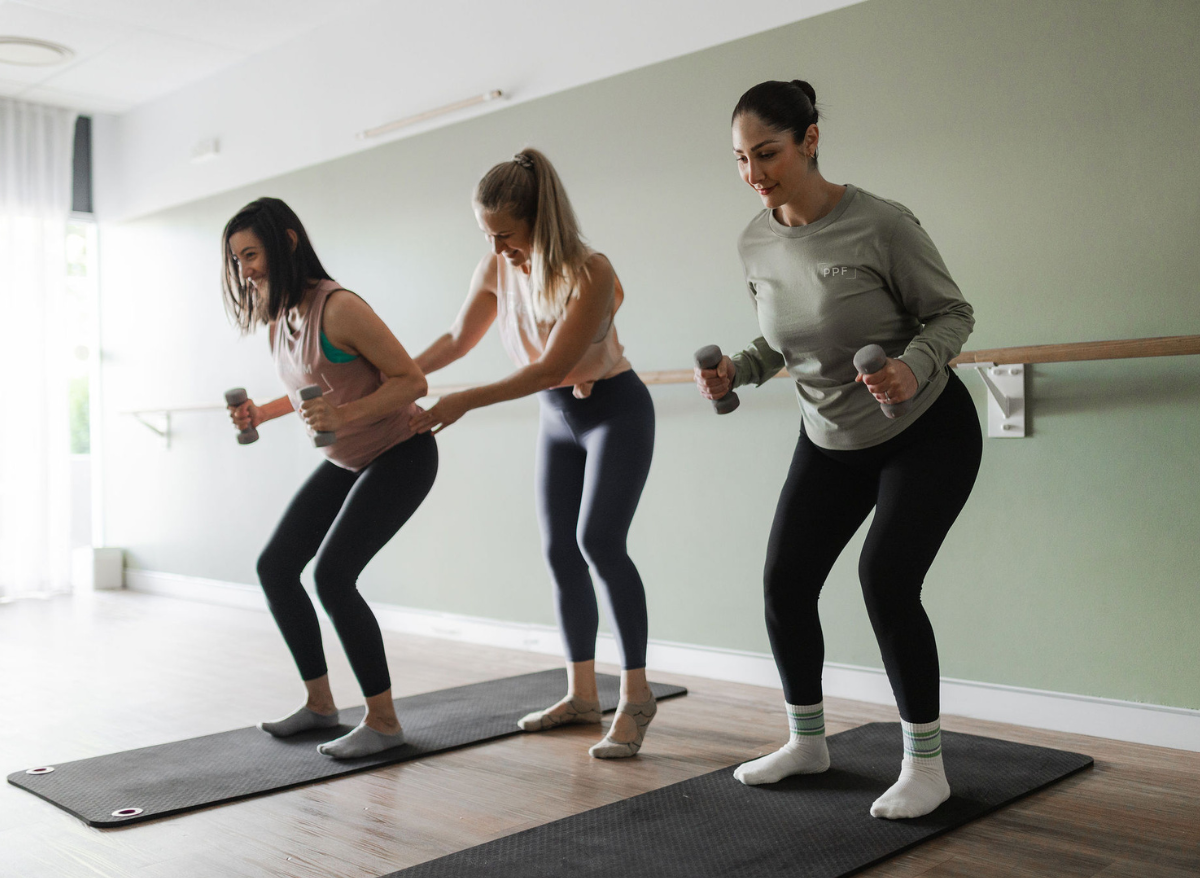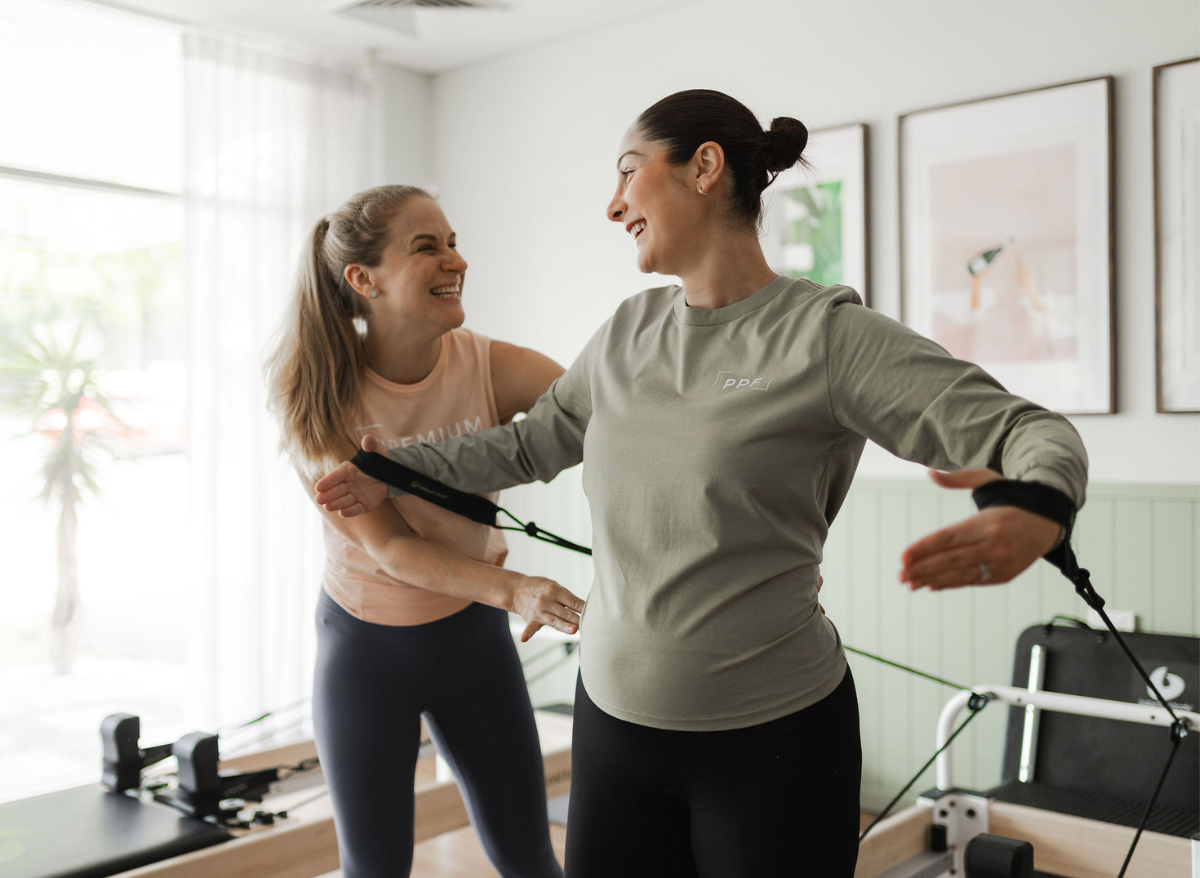If you’ve ever felt nervous about teaching a pregnant client, you’re not alone. In fact, most Pilates instructors I meet admit to a moment of hesitation when they see a baby bump walk into class. And it makes sense — you’re supporting not just one person, but two. It feels like precious life is in your hands.
But here’s the good news: with the right knowledge and training, you can feel completely confident in delivering safe, effective, and empowering classes for prenatal clients. I’ve been teaching Pilates for over 15 years, and it was during my first pregnancy I became passionate about learning everything I could about prenatal Pilates (I have three kids now and practiced Pilates while carrying all of them!). That journey led me to develop PPF’s dedicated Prenatal Matwork & Reformer Course, so instructors like you can feel prepared, supported, and excited when welcoming mums-to-be into your classes.

Why Prenatal Pilates Matters
Pilates is often recommended by doctors, physios, and midwives for expectant mothers, and for good reason. It helps improve posture, strengthen the core and pelvic floor, ease common pregnancy aches, and prepare the body for labour and recovery (Alagoz, et.al, 2025).
For instructors, being able to confidently teach prenatal clients not only benefits your clients’ health but also makes you a more versatile and employable teacher. Studios love having instructors who can adapt a class to meet the needs of every body — including pregnant clients.
Common Fears Pilates Instructors Have
As a studio owner and trainer of Pilates students, I hear the same concerns come up time and time again when it comes to teaching prenatal clients. Some of the most common fears are:
- “What if I do something wrong and cause harm?”
- “I don’t remember what’s safe and what’s not after the first trimester.”
- “What if the client doesn’t tell me she’s pregnant until partway through class?”
- “I’m not sure how to modify reformer or mat exercises for expecting mothers.”
These fears are completely valid — but they’re also completely solvable. What I’ve found is that instructors often hesitate not because they don’t care, but because they don’t feel confident in their knowledge. With solid training and a clear framework for modifications, those fears fade away and are replaced with a sense of empowerment.
The Theory of Pregnancy-Safe Pilates
Let’s get a little technical here, but don’t worry we’ll keep it approachable and useful. Teaching pregnant clients isn’t about creating a “special” class; it’s about understanding the physiological changes of pregnancy and adapting Pilates principles to meet those needs.
Key things to consider include:
- Trimester-specific modifications: As the pregnancy progresses, certain positions (like prolonged supine lying after the first trimester) and high-intensity moves should be avoided and/or adjusted.
- Breathing correctly: Teaching diaphragmatic breathing is super important, as it encourages both a relaxation and contraction of the pelvic floor, which is vital for pelvic floor health.
- Joint stability: Pregnancy hormones (like Relaxin and Oestrogen) increase ligament laxity, so stabilisation exercises are key to prevent injury. Some examples include exercises that engage the glutes whilst keeping the pelvis still, four-point kneeling exercises that involve the torso staying still as the arms and legs move and purely core activation exercises.
- Functional movement: Pilates is all about translating strength into daily life — and for prenatal clients, that means preparing them for lifting, bending, carrying, and eventually, birth and recovery. Daily movements such as rotating the torso, squatting whilst holding weight, reaching the arms overhead with load, sitting up to get out of bed and many more are all great exercises for a prenatal Pilates client to practice in a class (Theodorsen et.al, 2024).
- Whole abdominal wall focus: For the last decade or more, the fitness industry has been guided by expert doctors and physiotherapists, who stated that the only abdominals prenatal women should work is the pelvic floor and the transversus abdominis (the core). Women’s health physiotherapist Theodorsen conducted a study in 2024 that revealed the exact opposite: that whole abdominal wall training, working the rectus abdominis and the obliques, paired with pelvic floor and transversus abdominis activation, had no effect on abdominal separation (et.al). The study was then further analysed and revealed that prenatal women with a strong whole abdominal wall were less likely to experience pelvic girdle pain than prenatal women with weakened abdominals (from a lack of strengthening exercises). (Starzec-Proserpio et. al 2024). This shows the
The recently updated Australian Guidelines for Physical Activity during Pregnancy has reinforced that prenatal exercise, when guided safely, is not only beneficial but highly recommended for the health of expecting Mums. [2024).

Tips for Instructors
So, how can you feel more confident from the start? Here are some practical steps:
- Always ask: At the beginning of class, take time to ask prenatal clients how they are feeling, if there are any positions or exercises they are finding uncomfortable.
- Get the details: If a client is pregnant, ask which trimester they’re in, and whether they have any specific recommendations from their doctor.
- Prioritise safety: Stick to evidence-based guidelines and avoid exercises that could compromise stability.
- Stick to the Fundamentals: fundamental Pilates exercises are key for prenatal training. You cannot go wrong with core activation, side lying glutes, arm work that focuses on correct posture and bilateral limb loading (using two legs).
- Invest in training: A short Prenatal Pilates specific course can give you the clarity and confidence you need to adapt classes with ease.
How to Build Your Confidence
The number one way to reduce fear is to increase knowledge. Continued learning is essential, and practice under supervision can be invaluable when starting out. Surround yourself with a supportive community of instructors who can share tips and guidance, groups like the PPF Instructor Hub are perfect for this.
That’s exactly why I created the Intermediate Prenatal Matwork & Reformer Course. It’s designed to give you both the theoretical knowledge and the hands-on practical skills you need to safely and confidently teach prenatal clients — so you never have to second-guess yourself in class.

Conclusion
Teaching pregnant clients doesn’t have to be intimidating. With preparation, education, and the right tools, you can guide them safely and confidently through their Pilates journey. And in doing so, you’ll not only grow as an instructor but also make a real difference in the lives of mums-to-be.
If you’re ready to take that next step, explore our Intermediate Prenatal Matwork & Reformer Course and discover how empowering it feels to teach with confidence.
References:
Pelvic Health and Rehabilitation. (2020). Diaphragmatic Breathing. Retrieved January 20, 2020 from https://pelvicpainrehab.com/low-tone-pelvic-floor- dysfunction/4427/diaphragmatic-deep-belly-breathing
The Australian Guidelines for Physical Activity During Pregnancy, Australian Government Department of Health, 2024.
Theodorsen, et. al. (2024). Pregnant women may exercise both abdominal and pelvic floor muscles during pregnancy without increasing the diastasis recti abdominis: a randomised trial. Journal of Physiotherapy, Volume 70, Issue 2, Pgs 142-148. https://www.sciencedirect.com/journal/journal-of-physiotherapy/vol/70/issue/2
Alagoz, et. Al (2025). The effects of Pilates method in pregnant women: scoping review, BMC BMC Pregnancy Childbirth 25, 485 https://doi.org/10.1186/s12884-025-07622-z
Starzec-Proserpio et.al. (2022). The Association between Postpartum Pelvic Girdle Pain and Pelvic Floor Muscle Function, Diastasis Recti and Psychological Factors -A Matched Case-Control Study. International Journal of Environmental Research and Public Health. 19(10) : 6236. doi: 10.3390/ijerph19106236. PMID: 35627771; PMCID: PMC9141269.



